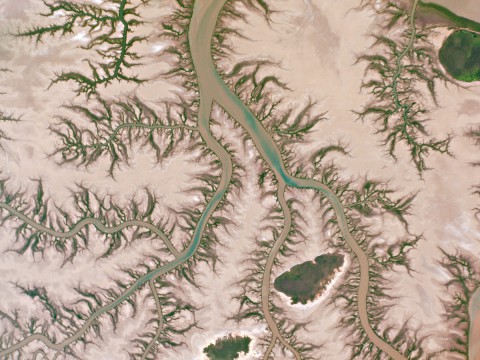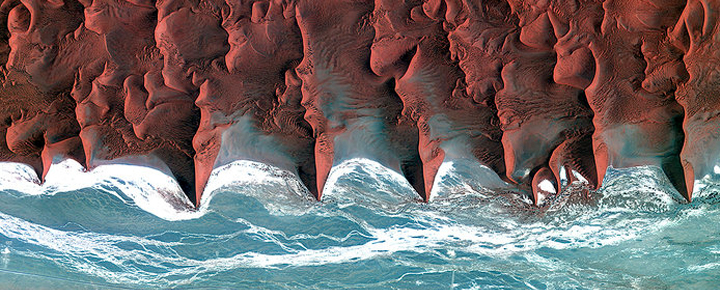“The world is full of magic things, patiently waiting for our senses to grow sharper.”
―W.B. Yeats
Human perception is a fickle, paradoxical instrument.
Our visual sense, while more acute than that of many species, is hardly the keenest in the animal kingdom. An eagle, for instance, has eyesight so sharp it can spot small prey more than three kilometers away. The next time you happen upon one in the wild, know that it saw you coming from afar, and waited patiently for you to arrive.
Birds are also “tetrachromats”; in addition to the spectra that are visible to humans, they possess a fourth kind of cone in their retinas, which allows them to see ultraviolet wavelengths of light. A very few human beings have inherited a genetic variant that confers tetrachromacy; they describe living in a world of spectacular subtlety and vibrancy, wholly unavailable to the rest of us, in which hundreds of unseen variations lurk in what we might otherwise label “green” or “blue.”
Other animals, especially small ones, sense time in ways that we might consider super-human. A common housefly processes about four times more visual information each second than a human being. Their “mental movie” is composed of two hundred and fifty frames per second; ours, a paltry sixty. As a consequence, some zoologists believe that a fly’s experience of time is radically slowed. To them, we appear as lumbering beasts, haplessly waving our rolled-up newspapers in slow motion.
One could fill a book with such unflattering comparisons, but don’t pity the poor humans. Over thousands of years of self-compounding refinement, we have managed to augment our otherwise provincial senses far beyond what any other animal might hope for. Indeed, this increasing sensual acuity is a central theme in the story of human progress.
Consider: In the 5th century BCE, the Greek philosopher Democritus first developed the (at the time, unobvious) idea that the world was filled with small, indivisible particles—άτομα. His contemporary, Aristotle, thought this idea was ludicrous, and the idea languished for centuries. Today, along the border between France and Switzerland, physicists at the Large Hadron Collider regularly accelerate subatomic particles to 99.999999% of the speed of light, and then smash them together in violent explosions that simulate the earliest moments after the Big Bang. In the resulting flash, which lasts for only a few billionths of a second, they glimpse the esoteric particles that form the basic building blocks of the universe. To even attempt this feat required the invention of detectors that are so exquisitely sensitive that they must be continually readjusted to compensate for minute fluctuations in the gravitational pull of the moon.
In a similar vein, we have peered further out into the inky darkness—and thus, further back in time—than any other animal. The universe is 13.7 billion years old. Human beings have built an instrument—the Planck Space Telescope—that has detected the dim remnants of radiation emitted when the cosmos was a mere 380 thousand years old—or 0.00002 billion years after its birth. Said another way: if the entire history of the cosmos were compressed into a year, we human beings have peered all the way back to the first ten minutes.
These Olympic feats of enhanced perception are among the crowning achievements of our species. Yet even as we celebrate them, our workaday senses remains stubbornly parochial.
Walking down the street, we easily sense changes that occur at a one or two meters per second, especially if those changes occur where our experience tells us they ought to. But, we’re terrible at sensing changes that unfold significantly faster—or slower—than our preferred speed, or occur where our experiences haven’t conditioned us to look.
This parochialism is part of the reason why we so poorly understand the world around us. Our planet is vastly larger and more complex than our ability to readily comprehend, and moves at speeds, and scales, and with interdependencies that do not conform to our everyday modes of thinking. If it did, climate change would have been solved long ago.
Paradoxically, humanity’s civilizing instinct inflames these perceptual biases. Civilization can be understood, in part, as the imposition of a kind of human-scale regularity upon the world. From inside it, it’s easy to forget that we nest, unsteadily, within the larger complexity of the whole—and not the other way around.
Now, thankfully, humanity is developing new technologies that can help us sense the world at scale, and make change visible in ways that are much more amenable to human cognition. And that matters, because seeing the world, deeply and in its totality, is the first step on the path to communion, empathy, and stewardship.

Mangroves spread in fractal patterns along the remote Keep River in Australia.
Image courtesy of Planet Labs.
For the past several years, I’ve been lucky enough to work with Earth-imaging specialists, planetary scientists, engineers and others who regularly peer at the world through a suite of these new instruments.

Uncontrolled peat fires in Indonesia, exacerbated by a strong El Nino.
Image courtesy of Planet Labs.
Some of these colleagues, at a company called Planet Labs, are deploying the largest constellation of Earth-observing satellites in human history. When fully operational, this system will collectively image the entire surface of the Earth, in high resolution, every day.

Luuq, Somalia rests in a large oxbow in the Jubba River, and is currently a haven for hundreds of Somalia’s “internally displaced persons.”
Image courtesy of Planet Labs.
Through the Planet Labs satellites (called Doves) and other Earth-imaging tools, on any given day, one can witness the world of the Anthropocene—the Age of Humans—in all its complexity. Agricultural fires signal the onset of the planting season in Brazil. Refugee camps expand along the Turkish border with Syria. Ice-flows dissolve off the coast of Nova Scotia. The Amazonian rainforest is slowly, and illegally denuded. Monolithic manufacturing complexes spread out in China. Megacities in Africa push ever outward. Crater-like remnants of nuclear bomb tests scar the Nevada desert. The density of nighttime illumination hints at the relative poverty, and equity, of human societies.

Nevada’s “Plutonium Valley”, where nuclear explosions, were tested in the 1950s, will remain radioactive for 400 generations.
Image courtesy of Planet Labs.
Not all of this sensing is done with satellites. At the University of Washington, computer scientist Ricardo Martin Brualla and his colleagues have developed software tools that harvest countless digital snapshots that we post on the Internet and synthesize them into films that show the aggregate change in one place over time.
(Above: The retreat of the Briksdalsbreen glacier in Norway, and the rise of the Las Vegas skyline, recomposed from hundreds of Internet photos, by Ricardo Martin Brualla and colleagues. Used by permission.)
For the first time in our history, broad access to these kinds of tools and imagery make visible, for anyone, the hidden dynamism of the planet—a dynamism that we spy occasionally, and only liminally, in our everyday life.
These images reveal not only change, but also vast diversity. Look upon the Earth long enough, and you will find almost every adjective fulfilled, somewhere. The world is beautiful, of course. But it is also sometimes ugly. It is intensely intertwined with human affairs, although it is sometimes indifferent or even overtly hostile to them. In some places, we are instruments of the world’s ruin; in others, less frequently, its regeneration.
The world is being built. It is growing. It is on fire. It is collapsing. It is in bloom. It is in decay.
And it is all these things at once.
Sitting with the grand simultaneity of it all, with the direct perception of boundless, kaleidoscopic global change, one begins to feel something new: the possibility of aplanetary sense.
And here is the crux of the matter: Earth observation, if entered into deeply, can be not only a psychological experience, but a spiritual one, too.
This requires not just looking, but beholding—to sit in deep and focused awareness, in full presence, without judgment.
Through this practice, we can begin to internalize the complex and subtle array of connections, patterns, and rhythms that dance upon the Earth. With practice, one can induce a kind of “perceptual flickering”—the rapid switching of awareness between radically different scales of time, space, and organization.
As this awareness grows, so too do a host of simultaneous emotions: joy at the breathtaking beauty of the world; wonder at is occasional, deep strangeness;empathy with its suffering; urgency toward the relief of that suffering. These, in turn, reinforce an abiding solidarity with the planet and its many inhabitants.
Still deeper, this solidarity gives way to a sense of unity. The subject-object distinction collapses, and we discover that the dynamism of the world does not end at the water’s edge of our senses. It continues inward. We contain, and are contained within, a great multitude of systems and processes—flickering into being, growing, ebbing, and renewing.
Such an observation should not be paralyzing, but liberating. The world has conspired to produce consciousness at the human scale, but it hasn’t limited our ability to sense or act solely to that scale.
Language sometimes fails us. It is predicated on syntactical rules that often reinforce our separateness. We read “Earth Day” through the lens of this linguistic separation—as if we were somehow outside of the Earth, and not, in reality, utterly cradled within it.
By cultivating our planetary sense, to look more directly at the world, we can push past the illusions of syntax, toward a deep, contemplative ecology, of which we are an integral part.
A version of this essay first appeared on the website of the Garrison Institute, where I serve as a Board member, to commemorate Earth Day.
